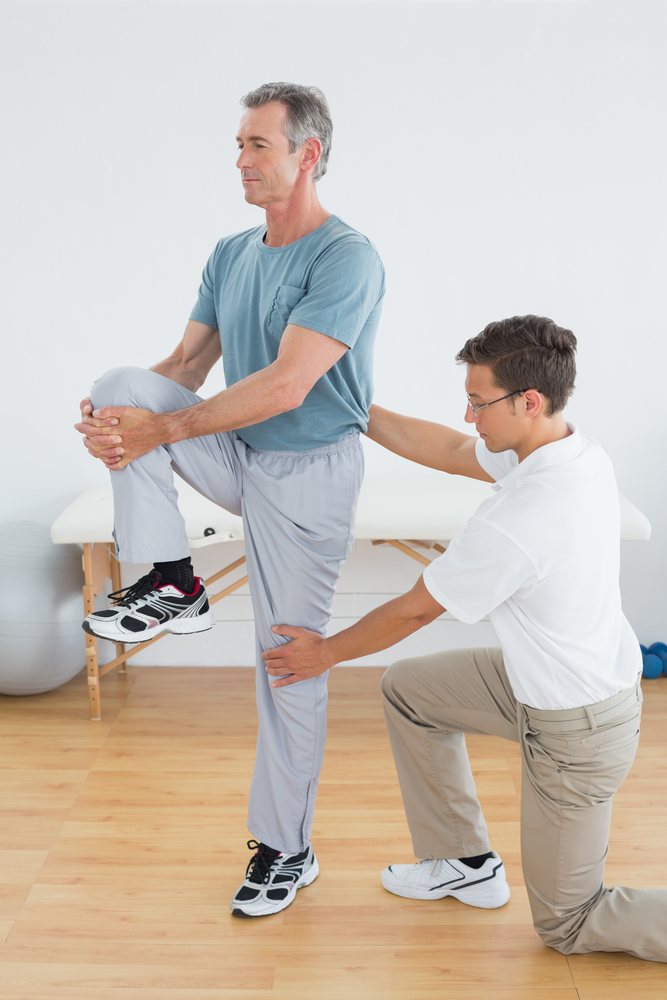As people grow older, their inner sense of balance changes. This can be due to a natural change in muscle tone or joint stiffness, or as a result of a physical/mental disorder. A weaker sense of balance prevents people from keeping their bodies stable, whether they are in a seated, standing or mobile position. Also known as vestibular rehabilitation, balance therapy is crucial to correcting internal balance issues quickly, improving stability and mobility. At Farmingdale Physical Therapy, our balance therapy treatments are targeted to address issues that each patient suffers from.
Symptoms of Balance Disorders
Because the symptoms can be easily confused with general clumsiness, balance issues are difficult to diagnose. However, balance disorders can be severe, and have a dramatic impact on one’s life. There are two primary types of balance disorders:
1. Static Balance Disorders
Static balance disorders are caused by an apparent lack of coordination when performing simple tasks. This includes:
- Tripping
- Swaying
- Stumbling
- Dizziness
- Vertigo
- Falling
2. Dynamic Balance Disorders
Dynamic balance disorders, on the other hand, affect people who only lose balance when multitasking. For example, dynamic balance disorders may cause people to have difficulty when walking and moving their head in another direction. It may also make walking in darker areas difficult. Our Long Island physical therapy practice can help you identify the issue, and come up with a suitable treatment.
What Causes Balance Issues?
Balance disorders are generally a consequence of another greater issue within the body. However, the root issue can vary from a cognitive disorder to a bodily injury. Our Long Island physical therapy office is equipped with knowledgeable staff who can determine the source of this issue.
Balance issues may cause people who were once physically active to refrain from physical activity, even simple daily tasks. This response, which prevents those with balance issues from embarrassing themselves after losing balance, can have a detrimental impact on the body. Adopting this sedentary lifestyle causes their muscle strength to decrease, which would gradually worsen the issue. This frustration could eventually lead people with balance issues to depression. Farmingdale Physical Therapy can outline a plan to assist people in regaining full control of their faculties.
Non-Condition Related
In some cases, balance problems might arise simply from a lack of coordination, due to one of the following factors:
- Stiff joints
- Inner ear issues
- Weakness in the muscles
- Antidepressants
- High blood pressure medication
- Sedentary lifestyle
- Old age
Condition/Injury Related
Many of the conditions that cause balance issues are commonly associated with hold age:
- Parkinson’s disease
- Multiple sclerosis
- Spine injury
- Cognitive/ brain diseases
- People who have previously had a stroke
- Arthritis
- Impaired vision
- Dysfunctional muscular symptoms
- Heightened awareness of the body

Diagnosis
At Farmingdale Physical Therapy, we conduct a thorough evaluation to determine the cause of the balance disorder. When determining how to proceed with a balance disorder patient, our Long Island physical therapy office takes the following into account:
- Frequency and severity of the balance issues
- Symptoms
- Current/previous injuries
- Lifestyle changes
- Medication
- Exercise habits
Top 5 Treatment Goals & Practices
At Farmingdale Physical Therapy, we design all of our treatments to be tailored toward the patient. By evaluating the strength of the muscles and joints, the health of the inner ear, the responsiveness of the eye, along with other factors, our Long Island Physical Therapy practice can determine the ideal treatment for you. These treatments are focused toward both correcting the physical disorder and reducing the fear of harm/miscoordination. Often, they include both in-home and guided exercises.
1. Decrease Risk of Falls
Ensuring that the home is a suitable environment is paramount to healing balance disorders. To limit falls in the home, our Long Island physical therapists will select footwear intended to provide the best possible stability. By inspecting your living space for any walking and tripping hazards, they will also eliminate any contributing factors.
2. Balance Exercises
Staying in tune with one’s body helps restore an inner sense of balance. To restore this sense of balance to its previous state, our Long Island physical therapists guide patients through peaceful, easy exercises. These exercises will improve both static and dynamic balance, meaning that they will have a positive impact on balance while both seated and standing.
3. Strength Training
Improving muscle strength is paramount to balance disorder recovery. At Farmingdale Physical Therapy, we assist patients in recovering muscle strength by improving stomach, trunk, and hip muscles. In turn, these muscles will improve the individual function of each part of the body, and consequently, balance.
4. Flexibility and Posture
Increasing flexibility works wonders for balance, too. With physical limitations in mind, we help our patients to increase their flexibility by stretching. This not only de-stresses muscles, but improves posture and balance, too.
5. Education
As experts on the subject, the staff at Farmingdale Physical Therapy will offer patients advice about how to change their lifestyle.
Ultimately, the goal of balance disorder treatment is to restore mobility, along with a sense of confidence that you can perform daily tasks. Our Long Island physical therapy practice will monitor patients closely, and tailor a multifaceted treatment to their needs.

